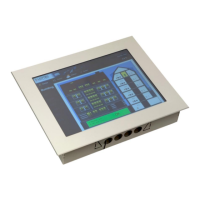L-VIS User Manual 299 LOYTEC
Version 6.2 LOYTEC electronics GmbH
%s The number of seconds since the Epoch, i.e., since 1970-01-01 00:00:00 UTC.
%S The second as a decimal number (range 00 to 61).
%t A tab character.
%T The time in 24-hour notation (%H:%M:%S).
%u The day of the week as a decimal, range 1 to 7, Monday being 1. See also %w.
%U The week number of the current year as a decimal number, range 00 to 53, starting
with the first Sunday as the first day of week 01. See also %V and %W.
%V The ISO 8601:1988 week number of the current year as a decimal number, range 01
to 53, where week 1 is the first week that has at least 4 days in the current year, and
with Monday as the first day of the week. See also %U and %W.
%w The day of the week as a decimal, range 0 to 6, Sunday being 0. See also %u.
%W The week number of the current year as a decimal number, range 00 to 53, starting
with the first Monday as the first day of week 01.
%x The preferred date representation for the current locale without the time.
%X The preferred time representation for the current locale without the date.
%y The year as a decimal number without a century (range 00 to 99).
%Y The year as a decimal number including the century.
%z The time-zone as hour offset from GMT. Required to emit RFC822-conformant
dates (using "%a, %d %b %Y %H:%M:%S %z").
%Z The time zone or name or abbreviation.
%+ The date and time in date(1) format.
%% A literal ‘%’ character.
Some conversion specifiers can be modified by preceding them by the E or O modifier to
indicate that an alternative format should be used. If the alternative format or specification
does not exist for the current locale, the behavior will be as if the unmodified conversion
specification were used. (SU) The Single Unix Specification mentions %Ec, %EC, %Ex,
%EX, %Ry, %EY, %Od, %Oe, %OH, %OI, %Om, %OM, %OS, %Ou, %OU, %OV,
%Ow, %OW, %Oy, where the effect of the O modifier is to use alternative numeric
symbols (say, roman numerals), and that of the E modifier is to use a locale-dependent
alternative representation.
15.7.3 Regular Expressions
A regular expression is a pattern that describes a set of strings. Regular expressions are
constructed analogously to arithmetic expressions, by using various operators to combine
smaller expressions.
15.7.3.1 Syntax
The fundamental building blocks are the regular expressions that match a single character.
Most characters, including all letters and digits, are regular expressions that match
themselves. Any meta-character with special meaning may be quoted by preceding it with a
backslash.

